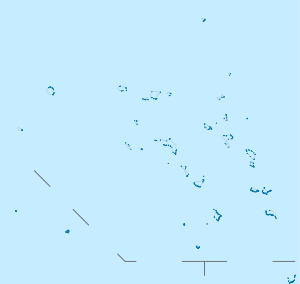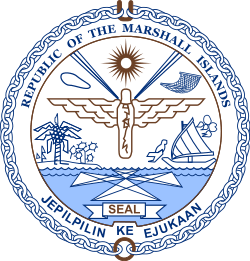Ebon Atoll
|
NASA picture of Ebon Atoll | |
 Ebon Atoll | |
| Geography | |
|---|---|
| Location | Eastern Micronesia, North Pacific |
| Coordinates | 04°38′00″N 168°43′00″E / 4.63333°N 168.71667°E |
| Archipelago | Ralik |
| Total islands | 22 |
| Area | 5.75 km2 (2.22 sq mi) |
| Highest elevation | 3 m (10 ft) |
| Administration | |
| Demographics | |
| Population | 706 (2011 [1]) |
| Ethnic groups | Marshallese |
Ebon Atoll (Marshallese: Epoon, [ɛ̯ɛbʲɛ͡ɔː͡ɛnʲ][2]) is a coral atoll of 22 islands in the Pacific Ocean, forming a legislative district of the Ralik Chain of the Marshall Islands. Its land area is 5.75 square kilometres (2.22 sq mi), and it encloses a deep lagoon with an area of 104 square kilometres (40 sq mi). A winding passage, the Ebon Channel, leads to the lagoon from the southwest edge of the atoll. Ebon Atoll is approximately 155 kilometres (96 mi) south of Jaluit, and it is the southernmost land mass of the Marshall Islands, on the southern extremity of the Ralik Chain. In documents and accounts from the 1800s, it was also known as Boston, Covell's Group, Fourteen Islands, and Linnez.[3]
History
Ebon Atoll was a center for commercial whaling in the 19th century. The schooner Glencoe had been taken and its crew massacred by Marshallese at Ebon in 1851, one of three vessels attacked in the Marshal Islands in 1851 and 1852.[4] There were several motives, and by some accounts the ship's crew had been abducting island women for sale to plantation owners in other destinations.[4] Missionaries sent by the American Board of Commissioners for Foreign Missions in Boston began missionary activities in the Marshall Islands in 1857, establishing a mission at Ebon.[4] It was claimed by the Empire of Germany along with the rest of the Marshall Islands in 1884, and the Germans established a trading outpost. After World War I, the island came under the South Pacific Mandate of the Empire of Japan, which had a garrison there late in World War II.
At the end of WWII, the island Atoll came under the control of the United States as part of the Trust Territory of the Pacific Islands until the independence of the Marshall Islands in 1986.
On January 30, 2014, castaway José Salvador Alvarenga, a Salvadorian national who had been working in Mexico as a fisherman, was found by locals on Ebon after he had pulled his boat ashore at the conclusion a 13-month drifting voyage of 6,700 miles (10,800 kilometers) across the Pacific.[5][6]
Demography
In the period between 1920 and 1999, different governmental officials have conducted eleven census reports from Ebon, with an average 735 total population.[7] The lowest count were under the Japanese colonial power in 1925, with 552 people, and the highest in 1999 – 20 years after independence — with 902 people. The most recent official census, conducted in 2011, has the total population at 706 people.[1] The same report also notes that Ebon is among the atolls and islands of the Marshalls with a positive net migration rate—even though the population has gone down with 196 people since the 1999 census. It is also curious to note that various German sources claims a significantly higher population—ranging from 1000 to 2000 people—in a 46-year period, 1860-1906. Moreover, in an unpublished interview series with Leonard Mason in 1949-50, Dwight Heine (an Ebon local) tells of a legendary typhoon that swept Ebon sometime in the 1850s.[8] Heine says, “During the typhoon and the civil strife…following the disaster, only one family survived.” The story says that a giant named Labun̄bun̄ was responsible for most of the destruction following the typhoon, and he left Ebon for Kosrae, where he married and had a son he named Telensa. Telensa, himself a big man, returned to Ebon with firearms and smokes. In the meantime, an irooj (chief) from Jaluit named Laukuk had moved to Ebon together with several families from Jaluit and Ailinglaplap. Since then, decedents of those people have owned and supervised the land. Before the typhoon hit, Heine says, the Ebon population numbered several thousands.
Today, people permanently inhabit four of the islets on the atoll. The main island, Ebon [Epoon], houses a medical facility and the council house, and is most numerous in population. Although more densely populated than Ebon, Tōkā has fewer residents. The other two are Enekoion [Āne-ko-ion] and Enilok [Āni-look]. Of the four, Āni-look is the only one without an elementary school, so children usually move to family members on Tōkā during school years. Many people have land rights on other islets, and live there sporadically to work with copra production. Of the islets with the largest production rate are Āne-armej, Kumkumļap and Enienaitok [Āni-eņ-aetok]—the islet where the Salvadorian castaway, José Salvador Alvarenga, ended his 13-month-long drift from Mexico on January 30, 2014.
References
- 1 2 Secretariat of the Pacific Community (2012). Republic of the Marshall Islands 2011 Census Report. Noumea, New Caledonia.
- ↑ Marshallese-English Dictionary - Place Name Index
- ↑ Spennemann, Dirk H.R. (ed.). "Atoll Information – Ebon Atoll (Marshall Islands)". Digital Micronesia. Charles Sturt University.
- 1 2 3 Hezel, Francis X. (1994). The First Taint of Civilization: A History of the Caroline and Marshall Islands in Pre-colonial Days, 1521-1885. University of Hawaii Press. pp. 200–202. ISBN 978-0-8248-1643-8.
- ↑ "Castaway claims he drifted 13 months in Pacific". CNN.
- ↑ Franklin, Jonathan (7 November 2015). "Lost at sea: the man who vanished for 14 months". The Guardian. Retrieved 7 November 2015.
- ↑ Gorenflo, L. J.; Levin, Michael J. (1994). "The Evolution of Regional Demography in the Marshall Islands". Pacific Studies. 17 (1): 93–158.
- ↑ Mason, Leonard (1950). Notes on Marshallese Culture in Ebon by Dwight Heine.
- Young, James Lyle. Spennemann, Dirk H.R., ed. "Brig Vision at Ebon Atoll (1876)". Digital Micronesia: Marshall Islands History Sources. Charles Sturt University.
- Marshall Islands site
- Oceandots entry for Ebon at the Wayback Machine (archived December 23, 2010)
| Wikimedia Commons has media related to Ebon Atoll. |
UNKNOWN HEROS, George W. Sciple, Williams & Company Publishers, Savannah, GA, 2003, 2006

